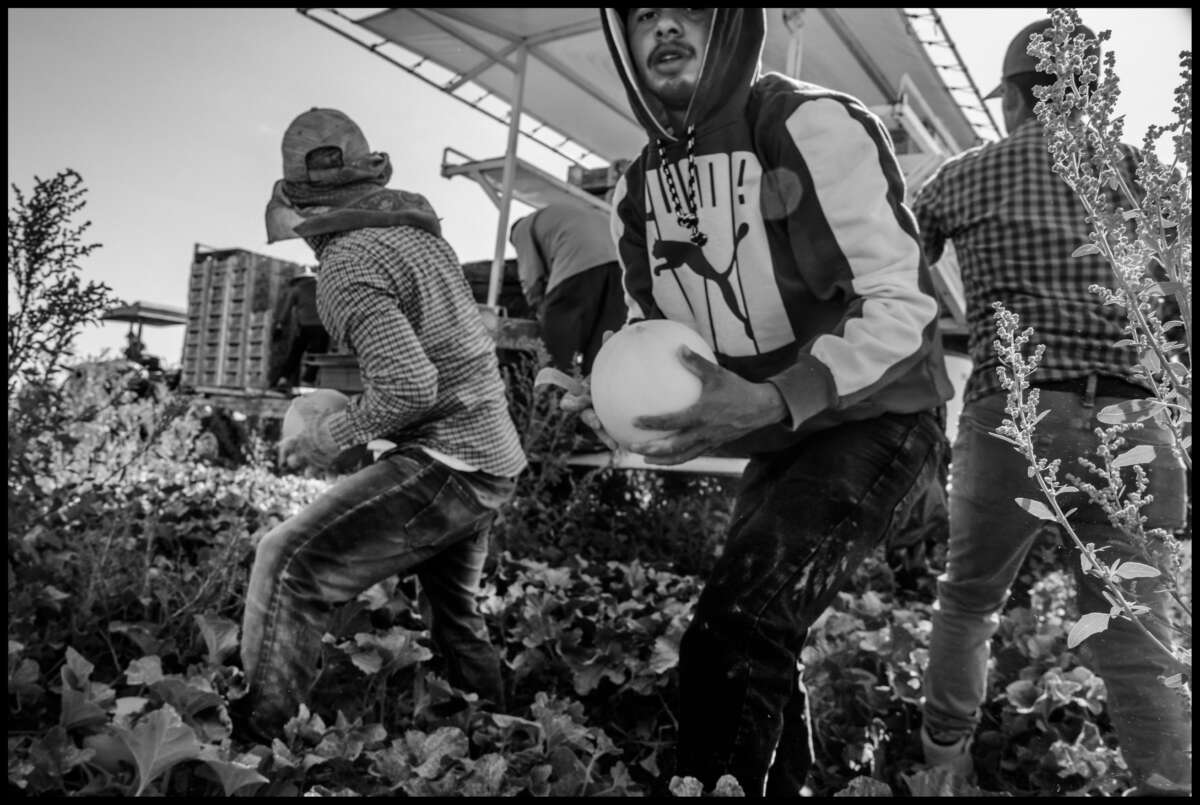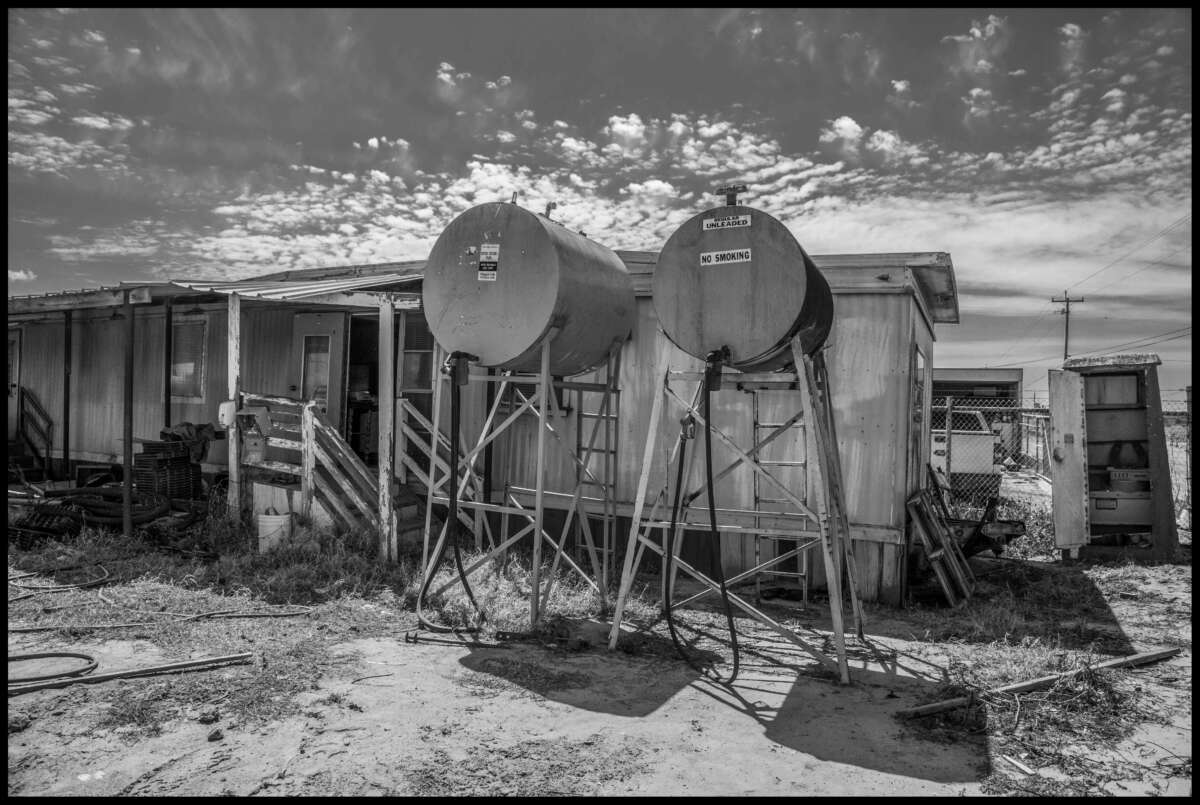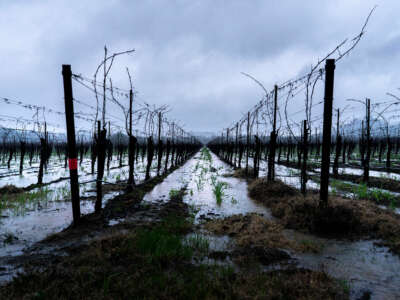Under the new visa pilot program, the administration is prioritizing growers’ profits over farmworkers’ rights.
By David Bacon ,

On September 22, 2023, the U.S. Department of Agriculture (USDA) announced it would begin paying growers to use the notorious H-2A contract foreign labor (or guestworker) program. Tapping into $65 million from the American Rescue Act, the USDA will pay between $25,000 and $2 million per application to defray the expenses of recruiting migrant workers from three Central American countries — Guatemala, Honduras and El Salvador — transporting them to the U.S., housing and feeding them while they’re here, and even subsidizing part of their wages. Labor contractors, who compete with each other to sell migrant farm labor to growers at low wages, will be eligible as well as growers themselves.
The H-2A program is the modern version of the old bracero scheme, under which growers brought Mexicans to work in U.S. fields from 1942 to 1964. Workers had to pay bribes to come, were kept separate from the local workforce, and deported if they protested or went on strike. Because of widespread abuse of the workers who came through the program, and growers’ use of bracero labor to prevent farmworkers from organizing, the program was abolished — one of the main achievements of the Chicano civil rights movement. But even at its height, the U.S. government never actually paid growers to bring in workers. Now, the Biden administration is doing just that.
The H-2A program allows growers to recruit workers, who today mostly come from Mexico. They can and do discriminate, hiring almost entirely young men and then pressuring them with production quotas to work as fast as possible. Workers have an H-2A visa, which allows them to stay only for the length of their contract — less than a year — and they cannot legally work for anyone other than the grower or labor contractor who recruits them. They can be fired for any reason, from protesting to working too slowly, and once they are terminated, they lose their visa and must leave the country. Recruiters maintain blacklists of workers fired for those reasons, and especially for striking and organizing, refusing to rehire them in future seasons.
The Biden administration’s purpose for its subsidy program, called the Farm Labor Stabilization and Protection Pilot Program (FLSPPP), is political. In announcing it, the USDA lists three goals. The first, “addressing current labor shortages in agriculture,” means not just giving growers a government-sponsored labor recruitment system, but even paying them to use it. While growers complain about labor shortages, unemployment in farmworker communities is higher than in urban areas. Agribusiness has been intent, however, on keeping wages extremely low. Many growers were Donald Trump supporters, and the rural areas of California and Washington State are still littered with old Trump signs from the 2020 campaign. But hope dies hard. The Biden campaign would welcome whatever support it can get from agribusiness in the tight 2024 election to come.
NEWS |Many farmworkers are still out of work and struggling to afford food in the wake of California’s disastrous floods.By Leanna First-Arai , TRUTHOUTJanuary 30, 2023
Samantha Power, administrator of the U.S. Agency for International Development, held a meeting with growers at the USDA in September 2022. She thanked them for working with the administration on “a critical priority — expanding the pool of H-2A farmworkers from Central America, specifically from El Salvador, Guatemala, and Honduras.” “We have got your back,” she promised them. “We are committed to helping maintain a strong pipeline of experienced farmworkers to support you.”
It is no coincidence that a work visa program is being unveiled as Biden negotiates with Republicans over measures to make the asylum process basically unavailable to those same migrants fleeing poverty and repression.
The second stated goal of the pilot program is to “reduce irregular migration from Northern Central America through the expansion of regular pathways.” As Republicans attack the president for being “soft” on immigration, the Biden administration hopes to forestall caravans arriving at the border by channeling thousands of potential migrants into work visa programs. The FLSPPP does nothing to change the conditions that produce migration, nor does it allow migrants to access the asylum system and become U.S. residents. In fact, it is no coincidence that a work visa program is being unveiled as Biden negotiates with Republicans over measures to make the asylum process basically unavailable to those same migrants fleeing poverty and repression.
The third goal, “improving the working conditions for all farmworkers,” is political theater. Applicants for subsidies under the pilot program are required to provide H-2A workers with living wages, overtime pay, workers’ rights training, health and safety protections, and no retaliation if they try to organize a union. These protections and benefits — in many cases, simply the base legal requirement — don’t even exist on paper for almost all farmworkers who are already living in the U.S. And because, according to the National Agricultural Workers Survey, about 44 percent of all farmworkers are undocumented, it’s difficult for them to use what legal protections exist. However, instead of pushing for immigration reform that would provide them with legal status, the Biden administration is helping growers bring in H-2A workers to replace them.

With weak enforcement on the ground, it’s unlikely that H-2A workers would get these benefits either. Violations of the rights and minimum standards for both H-2A and resident farmworkers are endemic in U.S. agriculture. The program contains no funding for even a minimal increase in Department of Labor (DoL) investigations of existing violations, much less those to come.
The proposal shocked many farmworker advocates and organizers. A number of them sent a letter of protest to the Biden administration, which I also signed as a fellow of the Oakland Institute. “As farmers, farmworkers, and their advocates, we are writing to express our indignation that USDA is committing $65 million of public money to pay farm employers, including Farm Labor Contractors, to raise wages, improve housing or other adjustments for H-2A workers before making any significant changes in the conditions of the millions of farmworkers already in this country,” the letter read.
Documentation of worker abuse in the H-2A program goes back decades, and many farmworker advocates and unions doubt it can be reformed. “Because of its record of abuse of both H-2A workers and local farmworkers,” the protest letter stated, “we have called for the abolition of the H-2A program for many years.” Sarait Martinez, director of the Binational Center for Oaxacan Indigenous Development, which organizes farmworkers against wage theft and other abuse, told Truthout, “This program pits resident farmworkers against contract workers recruited by growers, and makes it impossible to end the poverty in farmworker communities, treating it as normal and unalterable.”
“This program pits resident farmworkers against contract workers recruited by growers, and makes it impossible to end the poverty in farmworker communities, treating it as normal and unalterable.”
At the same time that USDA is handing out subsidies, the enforcement system that should protect farmworkers from wage theft, illegal wages, and other violations of workplace standards and rights is in freefall. A 2023 study by the Economic Policy Institute found that investigations by the Department of Labor’s Wage and Hour Division (WHD) have plummeted by over 60 percent — from a high of 2,431 in 2000 to only 879 in 2022. The department has only 810 investigators for the nation’s 164.3 million workers, or one inspector per 202,824 workers. As a result, the DoL only investigates fewer than 1 out of every 100 agricultural employers each year, although, notes the study, “when WHD does investigate an agricultural employer, 70 percent of the time, WHD detects wage and hour violations.”
From 2000 to 2022, violations of the H-2A visa program accounted for roughly half of the few cases in which employers were forced to pay back wages and civil penalties, rising to nearly three-fourths during the Biden administration. Because enforcement is weak, cases of employers and labor contractors using H-2A workers to replace local workers, and cheating those H-2A workers, are multiplying.
One example of cheating occurred with notorious labor violator Sierra del Tigre Farms in Santa Maria, California. In September 2023, more than 100 workers were terminated before their work contracts had ended and told to go back to Mexico. The company then refused to pay them the legally required wages they would have earned. Its alter ego, Savino Farms, had already been fined for the same violation four years earlier, an indication that the profits of labor violations outweigh the small penalties.
One worker, Felipe Ramos, was owed more than $2,600. “It was very hard,” he remembers. “I have a wife and baby girl, and they survive because I send money home every week. Everyone else was like that too. The company had problems finding buyers, and too many workers.” In fall 2023, Rancho Nuevo Harvesting, Inc., another labor contractor, was forced by the Department of Labor to pay $1 million in penalties and back wages to workers it had cheated in a similar case. The frequency and seriousness of these cases in one relatively small valley alone indicate that the problems with the program are fundamental, structural and widespread.
As the USDA “pilot” subsidy program is being rolled out, the U.S. Department of Labor has proposed a set of reforms it says may reduce the long-documented abuse of H-2A farmworkers. Yet even in the published text of the proposed reforms, the DoL staff who drafted it summarize the structural reasons that make the impact of reforms so doubtful:
Over the past decade, use of the H-2A program has grown dramatically while overall agricultural employment in the United States has remained stable, meaning that fewer domestic workers are employed as farmworkers. … Some of the characteristics of the H-2A program, including the temporary nature of the work, frequent geographic isolation of the workers, and dependency on a single employer, create a vulnerable population of workers for whom it is uniquely difficult to advocate or organize to seek better working conditions. … This lack of sufficient protections adversely affects the ability of domestic workers to advocate for acceptable working conditions, leading to reduced worker bargaining power and, ultimately, deterioration of working conditions in agricultural employment.
The existing local farmworker workforce suffers from the conditions the Department of Labor describes. In another wage theft claim in July 2023, a group of resident workers charged that high-end winery J. Lohr conspired with a group of labor contractors to pay less than the minimum wage, while hiding records of the violation. The Binational Center for Indigenous Community Development, which brought the suit, has fought five similar cases in the last year.
There is no requirement from the USDA that employers of local workers implement any of the pilot program’s conditions, and no additional resources are destined for defending the existing farmworker workforce.
Instead of spending its limited resources to protect and advance the wages and job rights of the farmworkers who live and work in the U.S. (68 percent of whom are immigrants themselves), the Biden administration is making it more attractive for growers to bring in guest workers to replace them. This gives growers a workforce that is easier to control, and who leave the country when the work is done. It continues a policy that extends back through the Trump, Obama, Bush and Clinton presidencies.
About 2 million workers labor in U.S. fields. Last year, the Department of Labor gave growers permission to bring 371,619 H-2A workers — or about a sixth of the entire U.S. farm labor workforce — an increase from 98,813 in 2012. Employing such a large quantity of H-2A labor cannot be done, as the DoL admits, without displacing domestic workers, who continue to endure extensive wage theft and an average family income of $20,000 per year.
Employers who hire local workers are ineligible for the pilot program subsidies unless they recruit H-2A workers — essentially bribing them to use H-2A workers to replace residents. There is no requirement from the USDA that employers of local workers implement any of the pilot program’s conditions, and no additional resources are destined for defending the existing farmworker workforce. This will directly hit farmworker families and communities across the country.
The Biden administration’s political calculations could prove disastrous as well. By doubling down on the program, it is essentially telling farmworkers and their advocates, in an election year, that the administration is solely concerned with the welfare of growers. Yet almost all farmworker unions and communities campaigned heavily against Trump in 2020. They were often Biden’s main support in rural areas where growers were solidly in the Republican camp.
“By implementing this pilot program, the Department of Agriculture has failed miserably to engage with us or hear our arguments,” the protest letter concluded. “We call upon USDA to cancel it and redirect the $65 million to a campaign to rebuild the domestic farm labor force.”
DAVID BACON is a writer and photographer, and former union organizer. He is the author of several books on labor, migration and the global economy, including In the Fields of the North / En los campos del norte, The Children of NAFTA, Communities Without Borders, Illegal People and The Right to Stay Home. His photographs and stories can be found at here and here.





